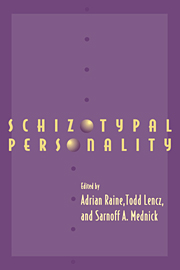Book contents
- Frontmatter
- Contents
- List of contributors
- Preface
- Acknowledgments
- Part I Introduction
- Part II Genetics and neurodevelopment
- 2 Family–genetic research and schizotypal personality
- 3 Schizotypal personality disorder characteristics associated with second-trimester disturbance of neural development
- 4 Neurodevelopmental processes in schizophrenia and schizotypal personality disorder
- Part III Assessment
- Part IV Categorical versus dimensional approaches
- Part V Psychophysiology and psychopharmacology
- Part VI Neuropsychology
- Part VII Brain imaging
- Part VIII Conclusion
- Part IX Appendix
- Name Index
- Subject Index
3 - Schizotypal personality disorder characteristics associated with second-trimester disturbance of neural development
from Part II - Genetics and neurodevelopment
Published online by Cambridge University Press: 04 August 2010
- Frontmatter
- Contents
- List of contributors
- Preface
- Acknowledgments
- Part I Introduction
- Part II Genetics and neurodevelopment
- 2 Family–genetic research and schizotypal personality
- 3 Schizotypal personality disorder characteristics associated with second-trimester disturbance of neural development
- 4 Neurodevelopmental processes in schizophrenia and schizotypal personality disorder
- Part III Assessment
- Part IV Categorical versus dimensional approaches
- Part V Psychophysiology and psychopharmacology
- Part VI Neuropsychology
- Part VII Brain imaging
- Part VIII Conclusion
- Part IX Appendix
- Name Index
- Subject Index
Summary
In this chapter we examine the hypothesis that second-trimester neural developmental disturbance is associated with increased presence of schizotypal personality disorder characteristics, which in turn increases the risk for adult schizophrenia. First, we review the literature on schizophrenia and neurodevelopment and the literature on schizotypal personality disorder (SPD) and neurodevelopment. Second, we report on findings relevant to the abovementioned hypothesis emanating from the Helsinki Influenza Project, which has studied a cohort of individuals exposed in utero to the 1957 type A2/Singapore influenza epidemic (Mednick, Machon, Huttunen, & Bonett, 1988).
Literature review
Schizophrenia and neurodevelopment
Central nervous system deficits were posited to underlie the disorder of schizophrenia since Kraepelin (1919) first formulated the term “dementia praecox.” Advances in technology have now provided empirical support of this earlier speculation. There now exists a solid body of evidence that schizophrenia may have as one of its bases an underlying neurodevelopmental etiology (Akbarian et al., 1993a,b; Mednick, Cannon, Barr, & LaFosse, 1991; Mednick, Machon, Huttunen, & Bonett, 1988; Waddington, Torrey, Crow, & Hirsch, 1991; Weinberger, 1986). Cytoarchitectonic studies have implicated brain areas and processes important in the development of positive schizophrenic symptoms; anatomical disturbances have been reported in the hippocampus and entorhinal cortex (Altshuler, Conrad, Kovelman, & Scheibel, 1987; Arnold, Hyman, Van Hoesen, & Damasio, 1991). Positron emission tomography (PET) and postmortem studies have, on the other hand, implicated brain structures/processes important in the development of negative symptoms; dysfunction and anatomical disturbances have been reported in the dorsolateral prefrontal cortex (Akbarian et al., 1993a,b; Tamminga et al., 1992).
The findings from the above studies, as a whole, have been interpreted as supporting a neurodevelopmental origin of schizophrenia (Machon & Mednick, 1994).
Keywords
- Type
- Chapter
- Information
- Schizotypal Personality , pp. 43 - 55Publisher: Cambridge University PressPrint publication year: 1995
- 1
- Cited by

